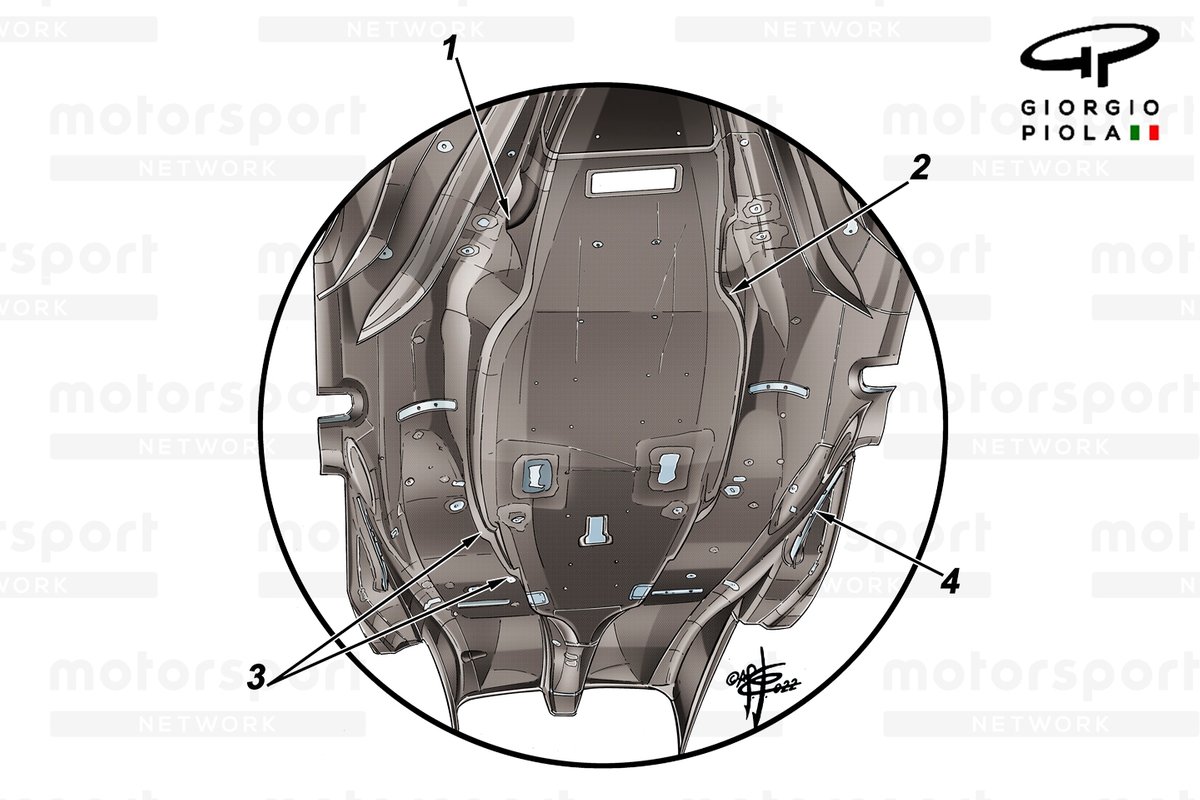
Let’s take a look at some of the more interesting solutions we’ve seen so far, which might be registering on the radar of other teams or has already influenced the design of aerodynamic updates up and down the grid.

The regulations permit teams to use a beam wing arrangement for the first time since 2013 again this season, with designers able to utilise two elements for both structural and aerodynamic purposes. Designers had followed the expected convention, with the two elements placed in series in order that they almost work as one larger surface.
However, Red Bull tore up the script and opted for a ‘stacked’ arrangement, whereby the two elements are mounted one above the other and almost work independently of each other. The design was quickly optimised after the first event, with the geometry of the lowermost element adjusted to better suit its demands.
Subsequently, we’ve even seen Red Bull remove the uppermost of the two elements at circuits that demand it runs with the lowest possible downforce arrangement, with Baku the first of those requiring a drag reduction. At the other end of the spectrum, and just before the summer break, the team opted for what we’d consider the conventional option at the Hungarian Grand Prix, as it loaded some additional downforce.
Red Bull is not the only team to have featured the stacked arrangement, as Alpine joined it at the Azerbaijan Grand Prix, with the Anglo-French squad producing a solution very similar to the one seen on the RB18 since the second event of the season.

The design scope of the front wing has been heavily curtailed over the course of the last few years, as the governing body has continuously sought ways in which to reduce the ability to generate outwash. Even with the introduction of much more prescriptive regulations this season, designers are still eagerly searching for ways to circumvent their intent.
Mercedes’ approach is the most extreme example we’ve seen so far, with the team finding a means to push the wing profiles as far forward as possible where they connect to the lower section of the endplate.
Having made this change at the Miami Grand Prix, the team went on to alter the position of the diveplane at Silverstone, lowering the element in order that the various flow structures in that region interacted with one another in the desired manner.

At the other end of the car, we’ve seen a fair amount of variation in terms of how the teams are dealing with the new rear wing design – not only in the distribution methodology of the mainplane but also in the transition between the flaps and the endplate.
Aston Martin upped the ante in Hungary with a design that has a little more in common with the old-style endplate design than the FIA intended when formulating the regulations. The design not only increases the span of the mainplane, given it now intersects with the endplate further outboard, it also reintroduces a surface that will undoubtedly alter the tip vortex too.
The overall goal of this design is to increase downforce but it had to be done in a way that not only ticked the various boxes required by the radius and curvature regulations, it also had to be relatively efficient too.

The floor on this year’s cars is incredibly important and Red Bull has one of the most intricate designs on the grid, especially when it comes to the detailing on the underside of the assembly. Notably other teams have followed in their footsteps when it comes to the revetted boat tail section [3] and the contoured hull [1 & 2].
However, there’s another solution that’s captured the imagination too, with the ‘Ice Skate’ on the underside of the floor acting as their edge wing [4].
The metal strake is connected to the floor, utilising the support brackets allowed within the regulations, of which six are permissible. The ice skate then offers not only aerodynamic support, with the airflow redirected by the structure, it also allows that section of the floor to run closer to the track’s surface without fear of the floor being damaged.
Both Ferrari and Alpine have since introduced their own variants of the ice skate solution, suggesting that Red Bull had found a performance enhancing solution that was relatively easy to understand and apply.

As part of its update package introduced at the British Grand Prix, Mercedes performed some interesting corrective surgery around the front suspension elements, bulking out the chassis’ volume to help improve flow conditions close to the W13’s body.
This falls in line with the team’s flow conditioning objectives given the sidepod solution it has opted for and also required the chassis canards ahead of the sidepod and the floor geometry and fences to be altered in order to fully exploit the volume changes, whilst the bib wing was also reoriented.
The designers also added fillet extensions to the suspension fairings too, resulting in the entire region acting as more like one larger flow conditioner.







